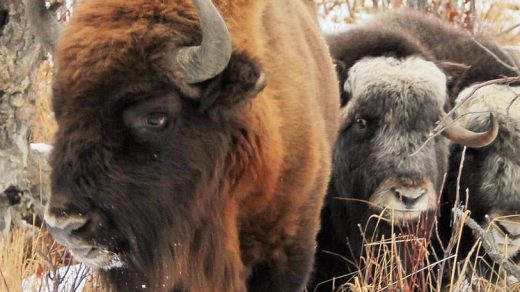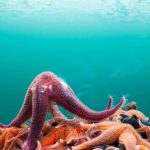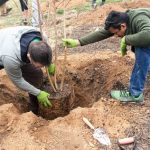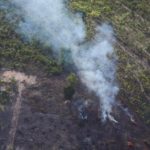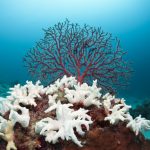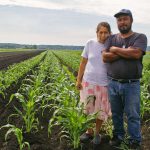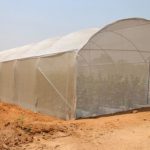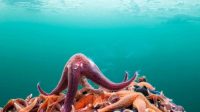Meet The Father-Son Duo Importing American Bison To Siberia To Save The Planet
In May, Russian scientists plan to load six American bison on heavy-duty trucks near the city of Perm, and then drive until the roads end in Siberia–a distance roughly twice the length of the drive from New York City to San Francisco. Their destination: Pleistocene Park, an experimental reserve that’s attempting to partially recreate an ecosystem that last existed more than 10,000 years ago.
At the time, woolly mammoths, bison, moose, yaks, and other herbivores grazed on massive grasslands. When the wildlife suddenly disappeared at the beginning of the Holocene Epoch–possibly because human hunters moved into the area–so did the grass. If animals come back, the reasoning goes, so will vegetation. And that restored ecosystem could protect the permafrost, a thick layer of frozen soil beneath the surface, from melting and releasing more emissions than all of the world’s fossil fuels.
“In 20 or 30 years, the permafrost will start melting everywhere if current trends persist,” says Nikita Zimov, director of Pleistocene Park. “It’s already starting to happen in some places.”

As permafrost melts, releasing tens of thousands of years’ worth of plants and animals frozen in the ice, the emissions from the rotting organic matter could rival the worst climate impacts from humans.
“I’ll give you a few numbers to put it in perspective,” says Max Holmes, the deputy director of Woods Hole Research Center, who studies climate change, particularly the impacts from the permafrost. “Right now, in the atmosphere, there are about 850 billion tons of carbon. In all the vegetation on earth, there are about 500 billion tons. And in the permafrost there are around 1,500 billion tons.”
If humans burn all of the oil, gas, coal left in the ground, “it’s something like 1,200 billion tons,” he says. “That’s all to say that it’s an awful lot of carbon” sequestered in the permafrost. If it continues thawing at current rates, Holmes says that current estimates suggest that 130 to 150 billion tons of emissions might be released this century. That’s comparable to adding another U.S.-sized emitter to the world.
The carbon and methane might stay locked in the permafrost if global warming suddenly stalled. But it’s otherwise difficult to stop the process, apart from some even wilder geo-engineering schemes like shooting aerosols in the air. The challenge is intensified by the fact that temperatures are warming faster in the Arctic than in other parts of the world. “There’s not much you can do directly with the permafrost,” says Holmes. “That’s the really intriguing thing about this sort of Pleistocene Park idea.”
The basic process works like this: During the winter, as animals trample the snow, it helps the extremely cold outdoor air reach the permafrost, preventing it from melting. (A thick layer of snow has the opposite effect, insulating the permafrost and keeping it warmer). Grasslands also reflect more sunlight than forests, which also keeps temperatures lower.
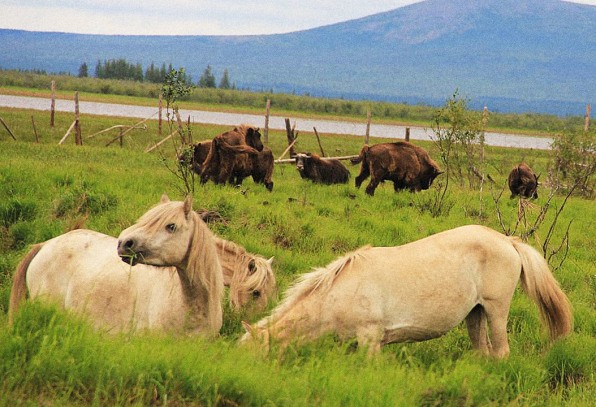
Now, in areas without animals, the snow-protected permafrost doesn’t freeze enough to maintain its temperature when the mercury rises during the summer, especially as temperatures increase. Over a large area, in theory, herds of animals could either protect permafrost from beginning to melt, or reverse melting after it has started.
“These highly productive steppe ecosystems can prevent the permafrost from melting if you’re starting early,” says Zimov. “If you have animals who would be introduced to degrading permafrost early, they can stop the erosion. Animals have the capacity to slow it down and stop, and freeze it back.”
Zimov and his father, Sergey, have worked on the park for two decades, fencing off around seven square miles of land in a remote corner of Arctic Siberia, and slowly bringing animals thousands of miles by truck and boat. There are currently 70 large herbivores in the park, from reindeer and musk ox to Yakutian horses.
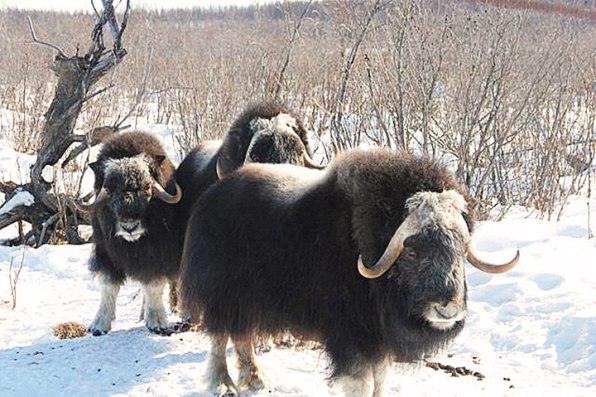
To date, they’ve funded the park themselves, investing nearly all of the money that they have earned through the private Arctic research station they run. But in a Kickstarter campaign, they’re trying to begin to scale up the project, starting with herds of bison, and, if they raise enough funds, yaks.
Both animals are also practical for a project with a small budget to obtain. Ideally, Zimov says, they would have imported wood bison, a species adapted to live further north than the American bison. But a park in Russia happened to have buffalo that it was willing to sell.
“Maybe the [American] bison is not as perfect as wood bison, but we believe that they will adapt normally to the place, and they will perform the ecological function,” he says.
Likewise, musk oxen would have been better for the park than yaks, but a single musk ox costs $10,000 (a yak retails for $1,500 to $2,000). “We tried to keep the goal as low as possible,” he says. “So yaks and bison are suitable, cheap, and relatively easy to get. We need to see how well they will do.”
In theory, the animals might be able to survive in the park on their own, but because of the expense of bringing them so far, the researchers will give them extra support. Simple shelters will help protect them from wind and cold in the winter, when temperatures can drop to below-58 degrees Fahrenheit (the animals are already used to cold temperatures, but for shorter periods of time). Extra forage will be available. This year, for the first time, a ranger with veterinary training will provide medical care if needed.
The researchers have also knocked down some of the trees that now cover part of the area; when large herbivores disappeared in the Pleistocene, part of the grassland was replaced by forest. (Without animals chewing on vegetation, shrubs and trees can grow). Though losing trees seems like it wouldn’t help the climate–in the Amazon, losing the rainforest is a major driver of emissions– grassland might help more in Siberia.
“It really highlights the difference between the Arctic and the tropics,” says Holmes. “If you’re in the tropics, if you’re in the Amazon, most carbon is in the trees and vegetation and the soil has very little carbon in it. And because it’s warm, this stuff decomposes in a hurry…in the Arctic, productivity is a lot lower, but decomposition is even slower.”

By one estimate, there may be 1,500 billion tons of carbon in the Arctic permafrost, versus just 25 billion tons in the vegetation.
Eventually, if science makes it possible, the researchers may bring woolly mammoths to the park; the mammoths would help knock down more trees. Harvard researcher George Church is attempting to “de-extinct” mammoths by using CRISPR gene-editing technology to alter Asian elephant genes. Someday, a baby woolly mammoth may be grown in a lab, and possibly end up in the park.
Zimov says that the restoration of the grassland can happen without all of the original species. “The expansion of ecosystems won’t be as fast without mammoths as with mammoths,” he says. “But all ecological functions can be obtained with other animals–I do not need mammoths to trample the snow, because horses and bison will do it as well as mammoths. So there is no need. Also, horses and bison will digest the grasses and return it to the nutrient cycle as quickly as mammoths do.”
So far, the animals introduced to the park have demonstrated that it is possible to begin to restore the grassland. But for the project to have an impact on curbing emissions, it would have to vastly expand; the park is only one tiny piece of the permafrost.
“Right now, it’s like an ecological desert,” Zimov says of the area. “There are few animals here. You can drive hundreds and hundreds of kilometers and you will not see a single animal in this place.”
To reach the scale needed to have an impact, the project would need much more support. “We can make it on the scale of a scientific experiment,” he says. “We bring some animals, we fence it, we feed them a little bit, we see how they transform the vegetation and how the permafrost gets colder. But if you want this to become an ecosystem big enough to have an effect on the climate, we need a bigger territory, we need more people, worldwide support, and government support. And most importantly, broad understanding of why that is important.”
In an ideal world, he says, any land that isn’t occupied by humans in Russia–and other parts of the world–would become part of a highly productive steppe ecosystem.
If the scientists can offer more proof about the process in Pleistocene Park, others may want to recreate something similar in Canada or in Alaska, where a herd of wood bison was recently reintroduced to the wild. “I think what the Zimovs have is this fascinating hypothesis and actually an experiment underway to test it,” says Holmes. “And what a lot of ways remains to be done is the hard core data supporting that hypothesis or not.”
In the meantime, the permafrost continues to melt. One crater in eastern Siberia–known as the doorway to hell–is now 282 feet deep.
Fast Company , Read Full Story
(153)

